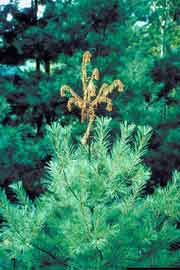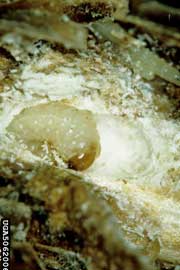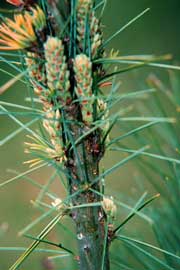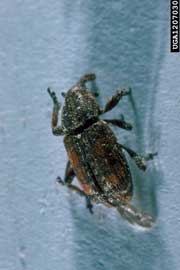White Pine Weevil—Pissodes strobi
The white pine weevil, which kills the top of conifers, is the most serious economic insect pest of white pine. One of the first symptoms of attack in the spring is the presence of pitch flowing from the feeding punctures in the previous year's leading shoot. Beginning in late June the new growth on infested shoots starts to droop. Shortly thereafter the tops die and turn brown. Up to 2-3 years of top growth may be destroyed. The damage results in trees that are multi-topped, crooked, and of much lower value for sawtimber. Plantations, open-grown trees, and ornamentals are most heavily affected. It attacks eastern white pine, Colorado blue spruce, Norway spruce, jack pine, Scotch pine, mugo pine, and native spruces.

The larvae do the most damage by killing leaders of infested trees. Leaders with expanding buds droop, forming the typical "Shepard's hook."

The larvae, which are found under the bark of the dying leader, are white, legless, C-shaped and have brown heads.
Click on images to view full-size
Identification and Control Information
- White Pine Weevil—Maine Forest Service
- Pruning to Manage White Pine Weevil—Maine Forest Service
- Pest Management Fact Sheet: White Pine Weevil—University of Maine Cooperative Extension
- White Pine Weevil—USDA Forest Service
- How to Manage Eastern White Pine to Minimize Damage from Blister Rust and White Pine Weevil—USDA Forest Service
- Entomological Notes: White Pine Weevil (PDF)—Penn State College of Agricultural Sciences Cooperative Extension
- Woody Ornamentals IPM Fact Sheets: White Pine Weevil (PDF)—Penn State College of Agricultural Sciences
More Information
- Maine Forest Service: Conditions Reports (updated regularly) including annual summary reports
[Photos, left to right: E. Bradford Walker, Vermont Department of Forests, Parks and Recreation, Bugwood.org; Rayanne Lehman, Pennsylvania Department of Agriculture, Bugwood.org; Dave Powell, USDA Forest Service, Bugwood.org; Joseph O'Brien, USDA Forest Service, Bugwood.org]

